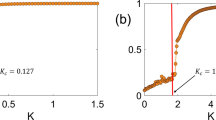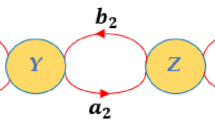Abstract
In this paper, we study the influence of the inertial effect on frequency synchronization in an ensemble of Kuramoto oscillators with finite inertia and symmetric and connected interactions. We present sufficient conditions in terms of coupling strength, algebraic connectivity, natural frequencies, and the inertial term to guarantee the occurrence of frequency synchronization. We also make a comparison with the existing conditions proposed for the first-order Kuramoto model and conclude that the inertial effect, if appropriately small, has little influence on frequency synchronization as long as the initial phase configurations are distributed in a half circle.
Similar content being viewed by others
References
Acebrón, J.A., et al.: The Kuramoto model: a simple paradigm for synchronization phenomena. Rev. Modern Phys. 77, 137–185 (2005)
Acebrón, J.A., Bonilla, L.L., Spigler, R.: Synchronization in populations of globally coupled oscillators with inertial effects. Phys. Rev. E 62, 3437–3454 (2000)
Choi, Y.P., Ha, S.Y., Yun, S.B.: Complete synchronization of Kuramoto oscillators with finite inertia. Phys. D 240, 32–44 (2011)
Choi, Y.P., et al.: Complete entrainment of Kuramoto oscillators with inertia on networks via gradient-like flow. J. Differ. Equ. 257, 2591–2621 (2014)
Chopra, N., Spong, M.W.: On exponential synchronization of Kuramoto oscillators. IEEE Trans. Autom. Control 54, 353–357 (2009)
Dörfler, F., Bullo, F.: On the critical coupling for Kuramoto oscillators. SIAM J. Appl. Dynam. Sys. 10, 1070–1099 (2011)
Dörfler, F., Bullo, F.: Synchronization and transient stability in power networks and nonuniform Kuramoto oscillators. SIAM J. Control Optim. 50, 1616–1642 (2012)
Dörfler, F., Bullo, F.: Exploring synchronization in complex oscillator networks. arXiv:1209.1335 [math.OC]
Fishman, R.S., Stroud, D.: Role of long-range Coulomb interactions in granular superconductors. Phys. Rev. B 38, 290–296 (1988)
Gendelman, O.V., Savin, A.V.: Normal heat conductivity of the one-dimensional lattice with periodic potential of nearest-neighbor interaction. Phys. Rev. Lett. 84, 2381–2384 (2000)
Giardiná, C., et al.: Finite thermal conductivity in 1D lattices. Phys. Rev. Lett. 84, 2144–2147 (2000)
Gushchin, A., Mallada, E., Tang, A.: Synchronization of heterogeneous Kuramoto oscillators with arbitrary topology. arXiv:1410.7448v1 [math.DS]
Ha, S.Y., Ha, T., Kim, J.H.: On the complete synchronization of the Kuramoto phase model. Phys. D 239, 1692–1700 (2010)
Ha, S.Y., Li, Z., Xue, X.: Formation of phase-locked states in a population of locally interacting Kuramoto oscillators. J. Differ. Equ. 255, 3053–3070 (2013)
Haraux, A., Jendoubi, M.A.: Convergence of solutions of second-order gradient-like systems with analytic nonlinearities. J. Differ. Equ. 144, 313–320 (1998)
Ha, S.Y., Kim, Y., Li, Z.: Large-time dynamics of Kuramoto oscillators under the effects of inertia and frustration. SIAM J. Appl. Dynam. Syst. 13, 466–492 (2014)
Hill, D.J., Chen, G.: Power systems as dynamic networks. In: Proceedings of the IEEE International Symposium on Circuits and systems, Kos, Greece, pp. 722–725 (2006)
Hong, H., Choi, M.Y., Yi, J., Soh, K.S.: Inertia effects on periodic synchronization in a system of coupled oscillators. Phys. Rev. E 59, 353–363 (1999)
Hong, H., Jeon, G.S., Choi, M.Y.: Spontaneous phase oscillation induced by inertia and time delay. Phys. Rev. E 65, 026208 (2002)
Hu, B., Qin, W.-X., Zheng, Z.: Rotation number of the overdamped Frenkel–Kontorova model with ac-driving. Phys. D 208, 172–190 (2005)
Jadbabaie, A., Motee, N., Barahona, M.: On the stability of the Kuramoto model of coupled nonlinear oscillators. In: Proceedings of the American Control Conference, Boston, Massachusetts, pp. 4296–4301 (2004)
Kuramoto, Y.: Self-entrainment of a population of coupled non-linear oscillators. In: Araki, H. (ed.) International Symposium on Mathematical Problems in Theoretical Physics. Lecture Notes in Physics, Vol. 39. Springer, Berlin, pp. 420–422 (1975)
LaSalle, J.P.: Stability theory for ordinary differential equations. J. Differ. Equ. 4, 57–65 (1968)
Mirollo, R., Strogatz, S.H.: The spectrum of the partially locked state for the Kuramoto model. J. Nonlinear Sci. 17, 309–347 (2007)
Mirollo, R., Strogatz, S.H.: The spectrum of the locked state for the Kuramoto model of coupled oscillators. Phys. D 205, 249–266 (2005)
Qin, W.-X., Xu, C.-L., Ma, X.: Stability of single-wave-form solutions in the underdamped Frenkel–Kontorova model. SIAM J. Math. Anal. 40, 952–967 (2008)
Qin, W.-X.: Frequency synchronization in networks of coupled oscillators, a monotone dynamical systems approach. Int. J. Bifur. Chaos 19, 4107–4116 (2009)
Qin, W.-X.: Rotating modes in the Frenkel–Kontorova model with periodic interaction potential. Discrete Contin. Dynam. Syst. (Ser. A) 27, 1147–1158 (2010)
Strogatz, S.H.: From Kuramoto to Crawford: exploring the onset of synchronization in populations of coupled oscillators. Phys. D 143, 1–20 (2000)
Takeno, S., Peyrard, M.: Nonlinear modes in coupled rotators models. Phys. D 92, 140–163 (1996)
Takeno, S., Peyrard, M.: Nonlinear rotating modes: Green’s-function solution. Phys. Rev. E 55, 1922–1928 (1997)
Tanaka, H.-A., Lichtenberg, A.J., Oishi, S.: First order phase transition resulting from finite inertia in coupled oscillator systems. Phys. Rev. Lett. 78, 2104–2107 (1997)
Wiesenfeld, K., Colet, P., Strogatz, S.H.: Frequency locking in Josephson arrays: connection with the Kuramoto model. Phys. Rev. E 57, 1563–1569 (1998)
Wu, C.W.: Synchronization in Complex Networks of Nonlinear Dynamical Systems. World Scientific, Singapore (2007)
Author information
Authors and Affiliations
Corresponding author
Additional information
Supported by the National Natural Science Foundation of China (11371270, 11071181).
Rights and permissions
About this article
Cite this article
Wang, R., Qin, WX. Inertial effect on frequency synchronization for the second-order Kuramoto model with local coupling. Z. Angew. Math. Phys. 68, 33 (2017). https://doi.org/10.1007/s00033-017-0778-8
Received:
Revised:
Published:
DOI: https://doi.org/10.1007/s00033-017-0778-8




